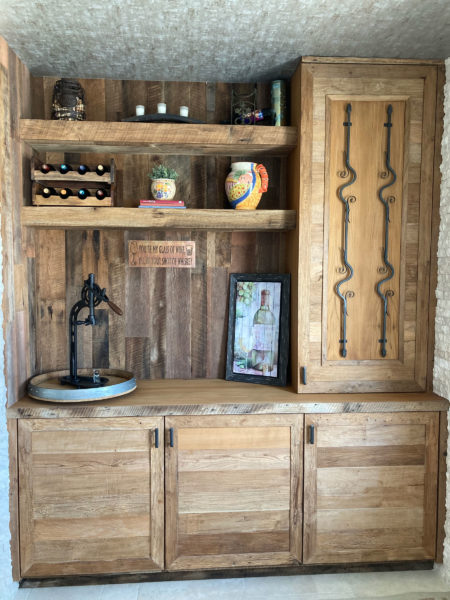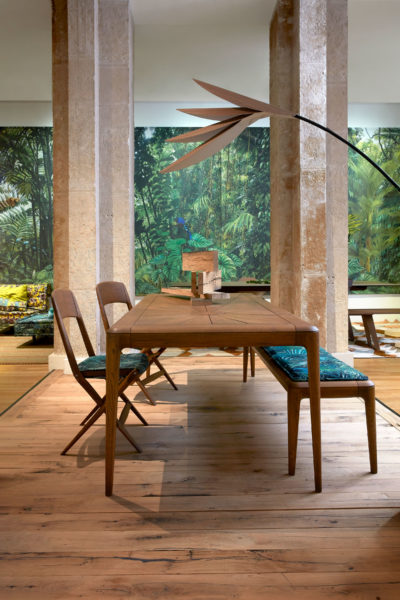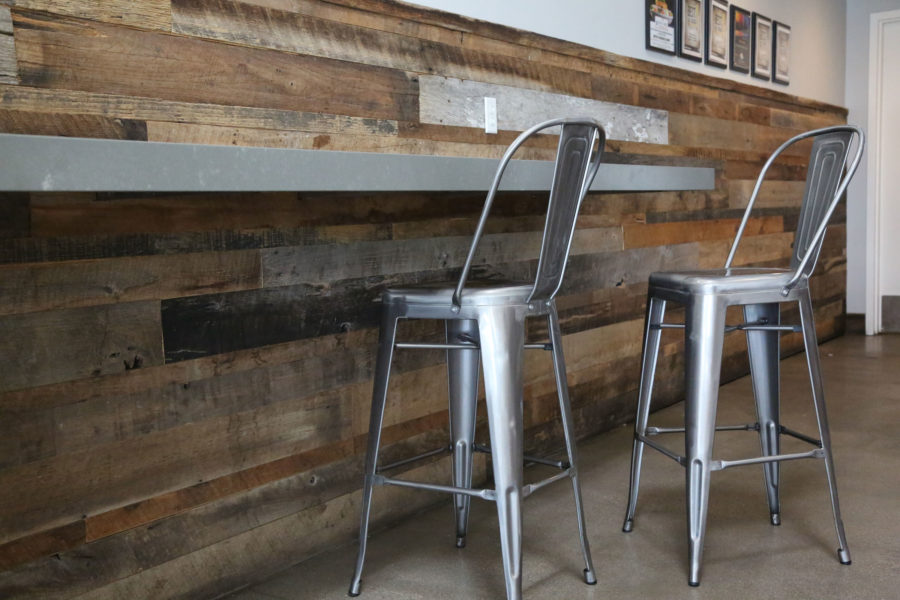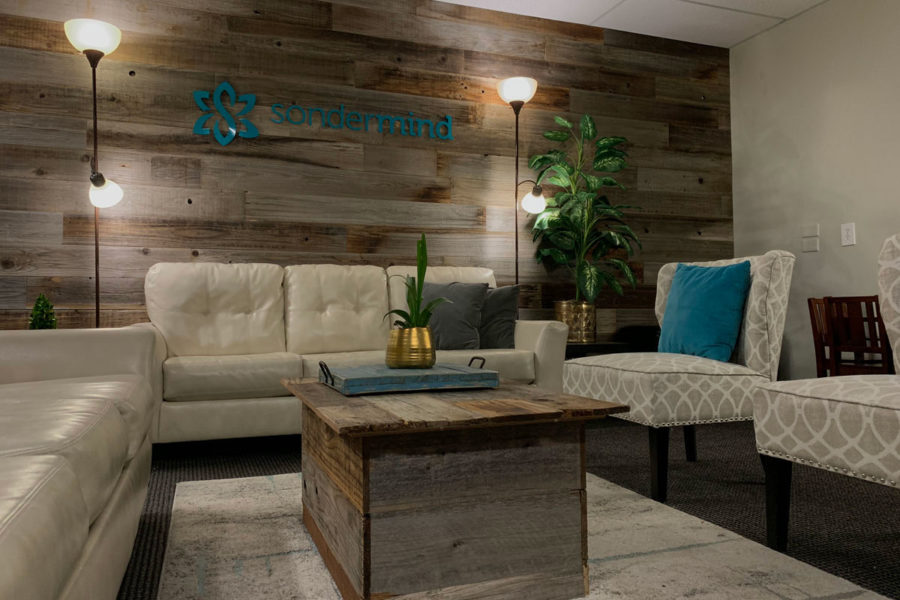Story at a glance:
- Several companies in the US specialize in crafting reclaimed wood furniture.
- Including reclaimed wood furniture in your interior design lowers the carbon footprint.
Green designers and builders spend most of their time searching for sustainable construction materials. This includes basics like the materials for the structure’s frame, exterior and interior walls, and roof.
Many of today’s design teams are working toward a sustainable interior design that syncs well with their physical building. Reclaimed wood furniture is one area that often fits in nicely to the overall vision.
What is Reclaimed Wood Furniture?

Indoor reclaimed teak wood built-in cabinetry by Woodstock Architectural Products. Photo courtesy of Woodstock Architectural Products
Reclaimed wood furniture refers to any interior or exterior furnishing constructed out of previously used wood or wood from trees felled because they were unwanted or considered hazardous. The term applies to chairs, tables, desks, doors, countertops, sofas, shelving units, cabinets, dressers, beds, and so much more.
Reclaimed wood may have been used in old houses, train stations, municipal buildings, places of worship, factories, commercial centers, barns, fences, or sailing vessels.
This wood has stood the test of time. It is highly valued because of its superior qualities and short supply. Likely cut in colonial times or during the period of Westward expansion from mature, old-growth forests, this wood comes from a variety of tree species.
Because of its age, reclaimed wood is extremely strong compared to the majority of today’s lumber cut from much younger southern yellow pine or Douglas fir trees.
Is Reclaimed Wood Good for Making Furniture?

AUREA table. Photo courtesy of Roche Bobois
Reclaimed wood from most sources is good for constructing anything—including furniture. Although most furniture doesn’t need to be extremely strong like houses need to be, exceptionally sturdy reclaimed wood used for home furnishings will last forever, barring taking an ax to it.
Companies that sell high-quality reclaimed wood to crafters intending to make furniture with it have already removed any nails or attached metal pieces for safety followed by filling in holes with wooden pegs. They also have performed a general cleanup to remove soil particles or debris. If needed, they have sanitized the wood to eliminate any mold or mildew, usually by steaming it. They will never resell termite-infected wood.
When Not to Use Reclaimed Wood
When buying reclaimed wood furniture, it’s important to make sure the wood was not originally treated with creosote, a toxic coal tar derivative believed to be carcinogenic.
For example, utility poles used to be treated with creosote until pentachlorophenol took its place in the 1960s. Many poles still in service contain creosote. Old poles are usually landfilled.
Like railroad ties, old utility poles are generally not used to make reclaimed wood furniture. Rest assured that reputable resellers will not chemically treat reclaimed wood with the harsh chemicals used today on most lumber, but it’s always good to inquire when in doubt.
Some resellers may test the reclaimed wood they intend to resell for heavy metals and other toxic chemicals. Asking about the previous history of the reclaimed wood in furniture you’re interested in purchasing or commissioning, as well as any toxicity testing, is also a good idea.
Benefits of Reclaimed Wood Furniture

Commercial restaurant reclaimed wood wall by Woodstock Walls. Photo courtesy of Woodstock Architectural Products
There are several benefits of reclaimed wood furniture. Here are the leading ones.
● Uniqueness. All reclaimed wood furnishings are handcrafted. Their special patinas bestow a warmth to your green interior design like modern furniture may not.
● Beauty. There simply is no comparison to the robust visual appeal of naturally seasoned wood.
● Historic preservation. Reclaimed wood furniture is rooted in history. These may make great talking pieces during dinner parties.
● Ecological conservation. The eco-friendliness of reclaimed wood furniture shines through. Upcycling wood results in no new deforestation.
● Low carbon footprint. Because no trees were cut to make a piece of reclaimed wood furniture, there are no carbon emissions associated with tree felling. Only a few carbon emissions occur during transport.
Disadvantages of Reclaimed Wood Furniture
Reclaimed wood furniture has a couple of disadvantages, such as:
● Possible unknown origin. A buyer may not be able to document the reclaimed wood’s origin. Without testing a sample, you won’t know if it contains any toxic chemicals.
● Flammable. Having been exposed to the sun for so long, reclaimed wood furniture is significantly drier than new wood pieces. Keeping the building where reclaimed furniture is located at proper indoor humidity (30 to 50% according to the EPA) should keep this risk under control.
Examples of Reclaimed Wood Furniture Companies

Indoor reclaimed wood accent wall and table by Woodstock Architectural Products. Photo courtesy of Woodstock Architectural Products
Many companies offer exquisite pieces of furniture made from reclaimed wood. Here are a few.
Sandtown Furniture Co.
“As almost all our pieces are, this table is built from wood that was salvaged from the City of Baltimore,” says Will Phillips, co-owner of Sandtown, in a previous interview with gb&d as he looks over a unique table. “The city runs a yard where they take fallen trees the city forestry service had to take down. We got lucky and scored this beautiful old black cherry tree.”
Roche Bobois
As gb&d highlighted in a previous article, Sacha Lakic designed the Aurea dining table using reclaimed oak planks from old mineral water wagons. This choice makes sense for the designer who specializes in both furniture and vehicle design, as the car influence is seen in the aerodynamic smooth lines and curved forms of the table. Perfect indoors or outdoors, this table adds a touch of dynamism to an age-old classic.
Coterie
Founded by Jaime and Carrie Covert, Coterie specializes in using reclaimed wood and metal to create sustainable furniture. “People think reclaimed wood is cheap, especially if they have a stash of it, but there’s a whole acclimatization process that has to go on in the shop before we can use it,” Carrie Covert told gb&d in a previous interview. Not to mention cleaning the wood. They’ve had to pull out not just nails, but bullets, dating back to the wood’s time as a tree.
That said, reclaimed lumber is one of Jaime’s favorite materials to work with, as it helps each piece tell a story, adding warmth, dimension, and context to a space or room. “I love working with reclaimed material,” he says. “When you’re cutting an old beam in a house that’s been there for 110 years, which used to be a 300-year-old tree, you’re getting textures and colors that are unexpected.”
Woodstock Architectural Products
Wood is like a natural sponge; that’s what Kevin Fults of Woodstock Architectural Products previously told gb&dPRO.
“It can work as an insulator with air pockets in its cellular structure that help it slow the conductivity of heat. Wood also absorbs moisture adding to improved indoor air quality. Its ability to moderate humidity maintains balance with surrounding air, meaning it will alter humidity when the air is too dry or too moist. Breathing easy is a breeze when using reclaimed wood in the interior of buildings.”




